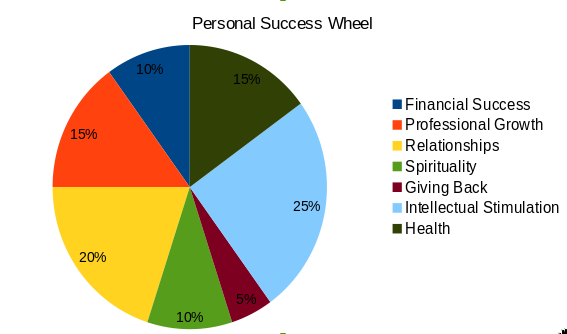.

When you make resolutions this year, tie them to the categories. As an example, for Giving Back, you could have:
- Charity
- Volunteer
- Mentoring
For intellectual stimulation, you could have:
- Learn Haskell
- Read the Wall Street Journal daily
- Read a certain blog
- Listen to a certain podcast weekly
And so on. Note that it’s possible for a goal to cover multiple categories.
Now is the time to be brutally accountable:
Say I put 25% of my time for Intellectual Stimulation. In a typical month, that’s 7-8 days. Sounds like a good amount. OK, let me look at all the goals I have for Intellectual Stimulation. Now knowing myself, this is going to be a long list. In previous years, I would simply prune it to what looked manageable and leave it at that.
But with the Personal Success Wheel, I can go one step further. Suppose I prune it to 8 items.
Great. I have 7-8 days a month to work on 8 items. That’s about 1 day per intellectual stimulation item. One of those items is “Learn Haskell”. Can I meaningfully learn much Haskell spending only 1 day a month on it?
No, I can’t.
So I have a few options:
- Increase the intellectual stimulation percentage to, say, 40 or 50%. And then deal with reducing the time for other categories to make room.
- Decide I can’t do 8 items this year for intellectual stimulation. So I need to prune the list further. I need to prioritize it. Maybe learning Haskell isn’t as important as some of the other items. Put them on the top, and if need be, just cut Haskell from the list.
(Yes, there is a minor flaw in the reasoning — the categories likely will overlap. Nevertheless, this will give you a good ballpark estimate).
I’ve never used the personal success wheel in previous years. I think I desperately need it. I’ve often complained to others that I fear my whole life will be spent as it always has: Taking on a lot of interesting items, and never getting far in any — at least not anywhere near as far as I would like.
This article is part of the series on New Year’s Resolutions.